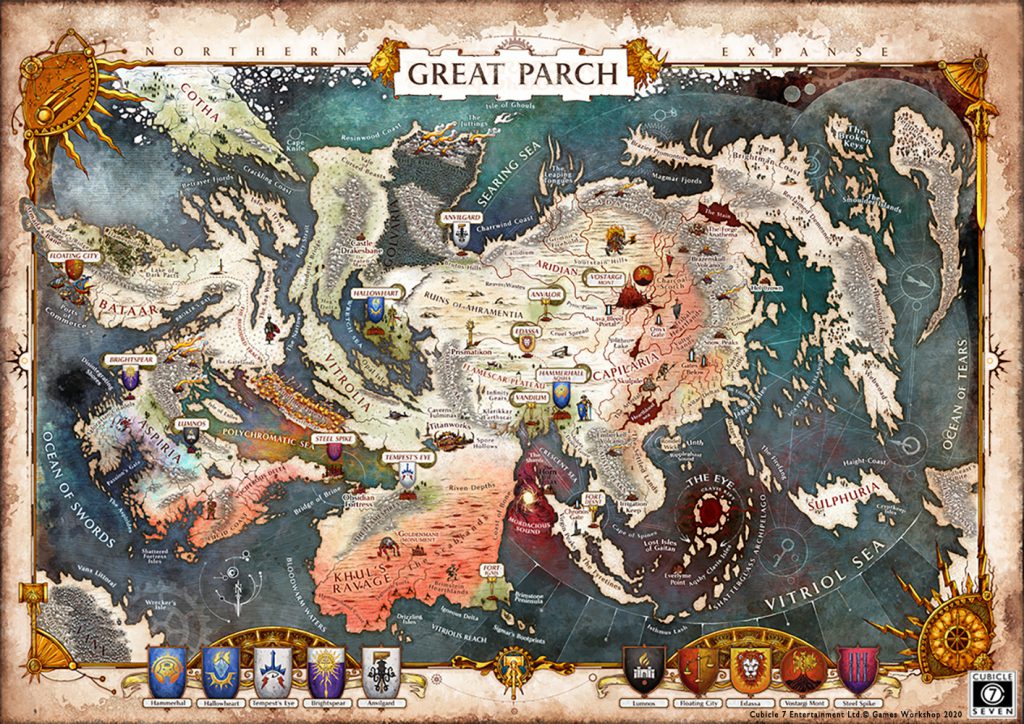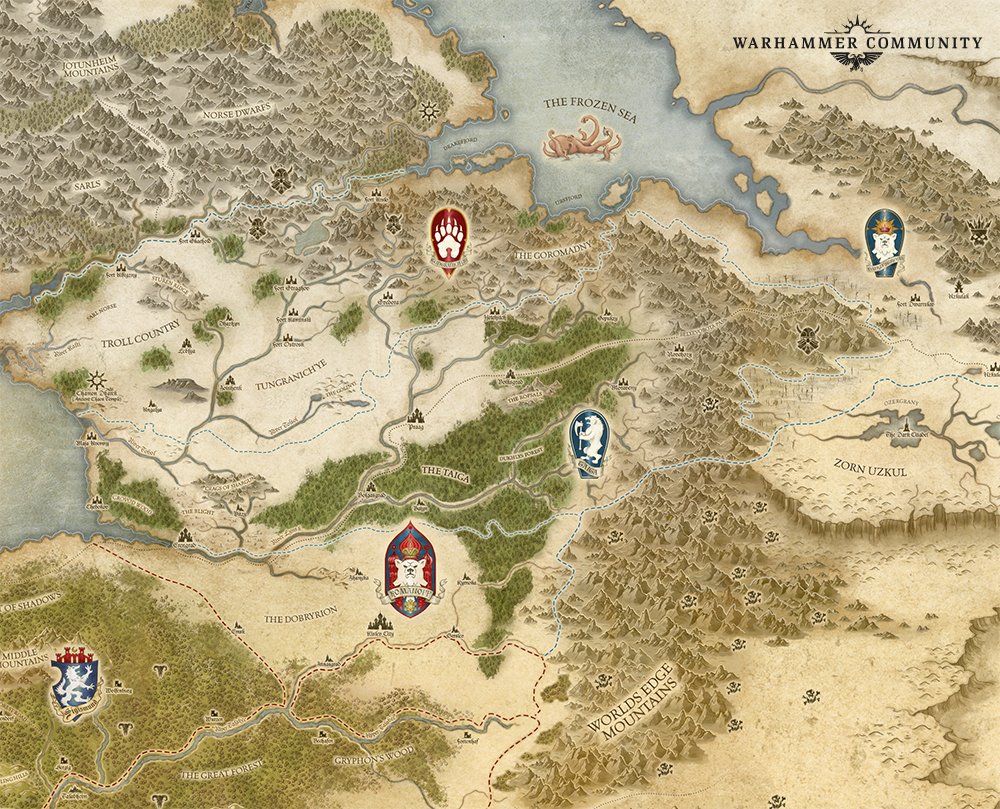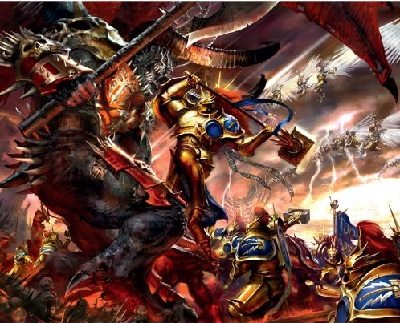One of the more interesting things to watch unfold is to see how GW has tried to develop the lore of Age of Sigmar. In the seven years since its release GW has tried to fill out the shell of its world through a staggering amount of development of its key characters. They have introduced new characters and races, had key cities fall and characters suffer losses or apotheosis. I want to look at the world as it stands now and compare it to how GW handled the Old World and how the setting impacts the nature of the stories being told. Now, it is unfair to compare the two fully as the Old World still has had a lot more time and care put into its development. So, keep in mind that the Age of Sigmar might be much more advanced in 10-15 years as it has had time to catch up.
Large vs. Small Scale
One of the first difference an observer will note is that the two systems are radically different in scale. The Old World is exactly that, a single planet while the Age of Sigmar practically covers an entire galaxy. This has several implications on the setting. Firstly, Age of Sigmar has more room to add Gods and massive monsters as they physically fit the setting. Outside of Nagash you really don’t have Gods manifesting in Sigmar and some of the newer characters would be comically out of scale with the setting. This has allowed the model designers to be more creative in their designs but also has a cost. Since the world is so big it makes it harder to care or even conceive of the setting. Sigmar’s scale makes it possible for everyone to home brew their own section of the universe, but this also means that it is difficult to establish clear distinct areas. Even though the realms are each different the armies tend to be largely the same in how they operate between realms making these differences appear superficial. I think GW is trying to remedy this by developing each realm through the narrative and themed releases. Sigmar is largely focused on your own force and it frees you to write your own lore.
The size is also a limitation for the Old World. With everything neatly and tightly mapped out its harder to home-brew your own faction or regiment to be of any import. The semi-strict faction locations also make it harder to justify why certain factions would fight in a narrative event (the old Kislev vs. Tomb Kings issue, similar to the old Necron vs. Necron issue of pre-5th ed. 40k). Furthermore, it becomes difficult to have big changes in the story with a small setting as if you destroy a major city you have to account for that in the future narrative. Although, this allows you to meaningfully raise the stakes whereas losing major cities is less of a crisis in a world that is massive and full of perfectly good alternatives.
High vs Low Fantasy
Another controversial comparison is the high fantasy vs mid-low fantasy aspects of the settings. Sigmar is a very high fantasy setting (although it does have low settings too as it tries to be all things to all people). While the Old World has a mainly middle-low setting (if focused on the Empire) with some smaller higher settings. Sigmar’s embrace of turning everything up to 11 in terms of model design and rules has alienated some players who think that it de-emphasizes the role of the common man in the story. By shifting this focus, heroism becomes more about being special and less about heroic acts committed by common people. It does allow for some pretty epic models and truly stunning kits though. It should also be noted that hero-hammer was alive and well in the Old World too. Arguably the most egalitarian race are the Skaven, especially in terms of having armies actually made up of common individuals as compared to elite warriors or outlandish beasts (though they had plenty of those too). However, this high setting allows for epic moments where beings of unfathomable power collide creating for some great art and storytelling. This setting allows certain characters to become the focal point of a story allowing for more development and tragic flaws.
One advantage of a lower setting is that it becomes a more human-focused story and people can imagine themselves living in the world more easily. Protagonist’s issues will be more akin to our own which makes it easier to empathize with them. While your stories might be less epic, they are also more grounded. Writers can explore simpler settings and provide local color through custom and culture rather than through crazy settings. It is more difficult to write this setting well but also more rewarding when done so.
High vs. Low Stakes
This might be a controversial take but I find the stakes in Age of Sigmar to be comparatively low. Partly this is because they already killed all the good guys off and blew up the world once so why would it happening again be that bad? Furthermore, the worlds are so vast and ill-defined allowing players to effectively ignore certain aspects of the lore they find inconvenient. While this is great for them, it does make it hard to care about the outcomes of the epic set pieces the writers draw up.
One issue of the high-stakes setting of the Old World is that it is more difficult for important things to happen without having to account for them in the fluff for all races. You also run into issues of constantly teasing players with the prospect of disaster only to walk back the consequences (We call this Eldrad-ing in 40k). This can cause players to stop caring as they don’t believe GW has the guts to do something controversial. Or that the situation isn’t actually that dire (see the End Time writer’s comments that: “There are as many elves as the plot demands”). I think this is why so many players were stunned at the writing at the close of the End Times (well aside from the sheer stupidity of how they did it).
Conclusion:
Well, I hope you all enjoyed my rambling monologue. It has been enlightening to see how GW has sought to pick up the narrative pieces of the End Times and assemble them into a new setting. I think the Age of Sigmar setting has its own quirks but is improving narratively. The choices made in regards to its setting have limitations but so did the Old World. In the next 10 years I am curious how the story will develop and grow. There are spaces in the new world for smaller stories and these can help patch some of these limitations. I would love to know your thoughts! Write something down in the comments if you agree or not.
And remember, Frontline Gaming sells gaming products at a discount, every day in their webcart!



